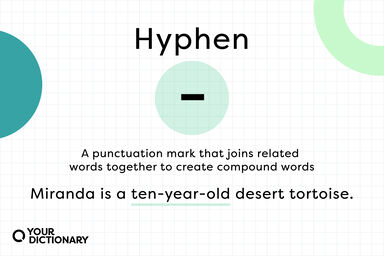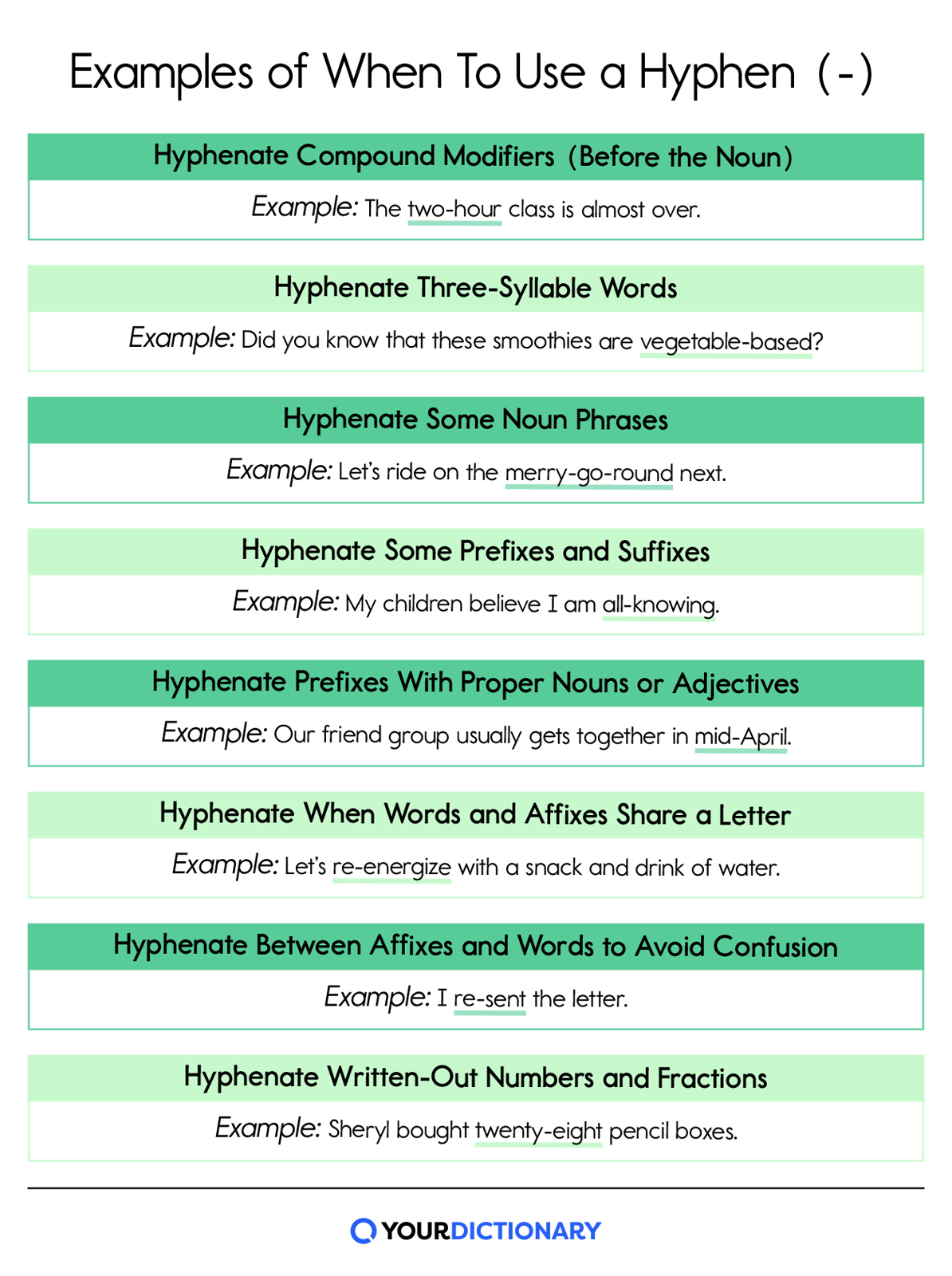What is Proper Way to Continue Writing Word on Two Lines With a Hyphen
When and How To Use a Hyphen ( - )
Hyphens join related words together in a sentence, such as in father-in-law, five-year-old and sugar-free. They prevent misunderstandings and clarify writing. But when should you use a hyphen — and is a hyphen the same thing as a dash? Find out when a hyphen is necessary, when it's optional, and when you don't need one at all.
 Hyphen symbol with definition and example from article underneath
Hyphen symbol with definition and example from article underneath
What Is a Hyphen?
Hyphens (-) join related words together to create compound words. They clarify word meaning, form new ideas, and allow writers to use language in a cool, creative way.
Hyphens can also indicate when a word is cut off, either at the end of a line or because someone stops speaking abruptly. ("Have you seen the pineapple mons-")
Are Hyphens and Dashes the Same Thing?
Combining two words makes a completely different word known as a compound word. Most compound words don't need a hyphen, but in some cases, they do. For example:
| Use a Hyphen | Hyphen Examples |
| when compound adjectives come before nouns | grass-fed beef |
| with compound words that aren't combined | editor-in-chief |
You may see these rules in sentences like:
- The two-hour class is almost over.
- It's a good idea to avoid lead-based paints if possible.
- Recess became a free-for-all once it started raining.
- This article about healthy eating is a real eye-opener.
Examples of Hyphens in a Sentence
Most of the time, adding affixes to a word doesn't require a hyphen. In some cases, however, it's a good idea to hyphenate the prefix or suffix to its base word, including:
| Use a Hyphen | Hyphen Examples |
| prefixes self-, all-, and ex- | self-esteem |
| prefixes and a noun that share a letter | re-energize |
| prefixes before proper nouns or adjectives | un-American |
| suffixes -elect and -odd | mayor-elect |
| suffixes with three-syllable nouns (or more) | adobe-like |
| when a noun and a suffix share a letter | Moab-bound |
Examples of these hyphen rules in a sentence include:
- Bullying can negatively affect teenagers' self-esteem. (Hyphenate self-)
- My children believe I am all-knowing. (Hyphenate all-)
- Do you know my ex-husband? (Hyphenate ex-)
- Let's conduct a meta-analysis of the research. (Hyphenate when prefix and word share a letter)
- That is a beautiful pre-Raphaelite painting. (Hyphenate when prefix comes before a proper noun or adjective)
- There will be thirty-odd kids at the party. (Hyphenate suffix -odd)
- I love these restaurant-style tortilla chips. (Hyphenate suffix when noun has three or more syllables)
- The pitcher has a drip-proof lid. (Hyphenate when suffix and word share a letter)

How To Type a Hyphen
You'll want to use a hyphen in a few additional situations. Compound numbers (numbers 21-99) and fractions always require hyphens when written out. It's also a good idea to include a hyphen when the unhyphenated version of the word is a completely different word (such as prefix, as in "a word placed in front of another" and pre-fix, as in "before a fix"). For example:
| Use a Hyphen | Hyphen Examples |
| with compound numbers (21-99) | forty-seven |
| with fractions (except one half) | two-thirds |
| to avoid confusion | re-pair (to pair again, not "repair") |
Examples of these hyphen rules in sentences include:
- The car was going fifty-five miles per hour. (Hyphenate compound numbers)
- Sheryl bought twenty-eight pencil boxes. (Hyphenate compound numbers)
- One-third of freshmen stayed in the dorms. (Hyphenate fractions)
- The kids ate three-quarters of the pizza. (Hyphenate fractions)
- I re-sent the letter. (Not resent)
- Most of the fans in the stadium are pro-State. (Not prostate)
When To Use a Hyphen
It seems like using a hyphen is often the safe choice in writing. Generally, that's true — although there are a few times when you shouldn't use hyphens. These occasions include:
- when a compound adjective follows the noun ("the well-known artist" vs. "the artist is well known")
- when an adverb ending in -ly modifies a noun ("the happily singing children")
- when using most prefixes or adjectives (countrywide, nondairy, untouched)
- in closed compound words (lighthouse, firefighter, keyboard)
Hyphenate Compound Modifiers (Before the Noun)
Many people confuse hyphens and dashes because they look similar in printing. However, they serve very different purposes.
- Hyphens (-) connect words and parts of words, and aren't separated by spaces.
- Dashes, (–) and (—), indicate ranges or pauses in writing, and are usually separated by spaces.
The common rule of thumb is to use a dash when showing a break in the text, a range in dates or time. Use a hyphen to create a connection between two words.

View & Download PDF
Hyphenate Three-Syllable Words
When compound words include a noun that's three syllables (or longer), adding a suffix may confuse the reader. Add a hyphen to clarify the meaning in these words.
- I've always wanted to live in an adobe-like house.
- Did you know these smoothies are vegetable-based?
- After she bought her dress, Maggie was homecoming-ready.
- The chilly air gave the yard a refrigerator-esque quality.
Hyphenate Some Noun Phrases
Certain noun phrases, such as mother-in-law or six-pack, are always hyphenated. Just consider the sentences "I love my mother-in-law" and "I love my mother in law" — is the speaker saying they love their spouse's mother, or that they love their mother in the profession of law?
These noun phrases usually have a non-principal word, such as an article or preposition, between two other words. The rule also applies to nouns with equal status (such as singer-songwriter).
- My brother is a jack-of-all-trades in construction.
- Let's ride on the merry-go-round next.
- Ignacio spoke in a matter-of-fact tone.
- Recess became a free-for-all once it started raining.
Hyphenate Some Prefixes and Suffixes
Nine times out of ten, adding a prefix to a word doesn't require a hyphen. But that tenth time always requires a hyphen — especially if the prefix is self-, ex-, or all-. (Add co- to the list when you're talking about a profession.)
- Bullying can negatively affect teenagers' self-esteem.
- My children believe I am all-knowing.
- Do you know my ex-husband?
- I'm co-editor of a medical journal.
The suffixes -elect-, -odd, -free, and -style are also always hyphenated, no matter where they appear in a sentence.
- The president-elect is making her victory speech any minute.
- Twenty-odd kindergartners ran around the playground.
- Did you know that the wedding is child-free?
- I love New York pizza, but my favorite is Chicago-style.
Hyphenate Prefixes With Proper Nouns or Adjectives
Add hyphens between any prefix that comes before a proper noun or proper adjective.
- That is a beautiful pre-Raphaelite painting.
- We deem the traitor's actions to be un-American.
- Our friend group usually gets together in mid-April.
- The post-Renaissance focus on scientific principles led to the Enlightenment.
Hyphenate When Words and Affixes Share a Letter
Sometimes, a prefix or suffix shares a letter with the noun it's attached to. In these cases, a hyphen can eliminate any misunderstanding or misspelling.
- Let's re-energize with a snack and drink of water.
- Sean takes an anti-inflammatory pill once a day.
- We're Moab-bound on our road trip this summer.
- Lila examined the shell-like stones on the beach.
Hyphenate Between Affixes and Words to Avoid Confusion
There's a big difference between the homographs resign and re-sign — one means "to quit," the other means "to sign again." Luckily, we have hyphens to help differentiate between words that use the same affixes but mean very different things.
- I resent your letter. (I take offense at your letter.)
- I re-sent the letter. (I sent the letter again.)
- Please repair my phone. (Please fix my phone.)
- Please re-pair my phone. (Please reconnect my phone to another device.)
- Do you need a prefix? (Do you need an affix in front of a word?)
- Do you need a pre-fix? (Do you need something fixed before a task?)
Hyphenate Written-Out Numbers and Fractions
When writing out numbers, hyphenate compound numbers between 21 and 99. (Don't use a hyphen for higher numbers.)
- The car was going fifty-five miles per hour.
- Sheryl bought twenty-eight pencil boxes.
- Are you really ninety-six years old?
You should also hyphenate fractions when writing them out, except for one half (no hyphen).
- One-third of freshmen stayed in the dorms.
- The kids ate three-quarters of the pizza.
- Possession is nine-tenths of the law.
When Not To Use a Hyphen
So are there times when you shouldn't use a hyphen? Believe it or not, you don't need a hyphen in most cases — but you especially don't need one in these cases.
Don't use a hyphen:
- when a compound adjective follows the noun (the well-known artist vs. the artist is well known)
- when an adverb ending in -ly modifies a noun (the happily singing children)
- when using most prefixes or adjectives (countrywide, nondairy, untouched)
- in closed compound words (lighthouse, firefighter, keyboard)
- in the fraction one half
What Does "Hyphen" Mean?
The word hyphen comes from the Greek words hypo- ("under") and -hen ("one"). Put together, the Greek hyphen means "under one" or "together as one" — as in, connecting two separate words as one word.
Hyphens date all the way back to the second century B.C. when they were invented by Greek grammarian Dionysius Thrax. They connected compound words and, upon the invention of Johannes Gutenberg's printing press, signaled that a word at the end of a typed line would continue on the line below.
The hyphen was one of the original punctuation marks included on a typewriter (which, coincidentally, used to be hyphenated as type-writer). Today, it remains as helpful as all the other punctuation marks, if not a bit underappreciated.
Hype Up for Hyphens
Hyphens can help you through all sorts of vocabulary vexations. But knowing the rules for hyphens is only the first part.
As English evolves, more and more hyphenated words lose their hyphens (even the unhyphenated mother in law has become more popular than the properly hyphenated mother-in-law).
Source: https://grammar.yourdictionary.com/punctuation/hyphen-rules.html
0 Response to "What is Proper Way to Continue Writing Word on Two Lines With a Hyphen"
Yorum Gönder